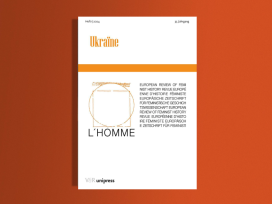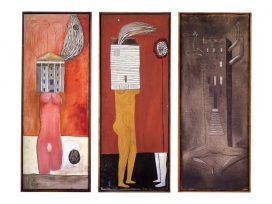Abstracts for L'Homme 2/2005
Hanna Hacker
Know white no white. Transitions between Critical Whiteness Studies and feminist theory
The paper first presents a few key definitions of “white”, “white culture”, “white supremacy” in Critical Whiteness Studies (CWS). The following introduction into CWS approaches in different scholarly disciplines comprises an overview of CWS in literary criticism, art history, colonial history, and postcolonial studies, focusing on “master texts” such as Manet’s painting “Olympia” (1863), “master artifacts” like the transparent soap in nineteenth-century commodity racism, or Frantz Fanon’s “master quote”, “Look, a negro! I’m scared!” Eventually, the paper analyzes Joyce Ladner’s anthology “The Death of White Sociology” (1973) as an ambiguous precursor to feminist dealings with hegemonic Whiteness and the respective conflicts within second-wave feminism.
The subsequent discussion of “color conscious” feminist approaches traces the rise of postcolonial and “third world” voices within the second (and third) wave – concepts like “womanism” or “mestíza consciousness” herein figuring prominently –, and simultaneously problematizes the feminist historiographic master narrative(s) about the origin and the course of white/non-white negotiations. At this point, the paper brings in some moments of “whitening” in German and Austrian feminist phantasmic productions, and eventually poses questions about the repeated white/non-white conflicts in feminist practice and theory, ongoing despite the obvious “boom” in CWS and Diversity Studies.
Natasha Distiller & Meg Samuelson
“Denying the coloured mother”: Gender and race in South Africa
This article brings to light, contextualises, and makes use of, some of the historical writings of Marie Kathleen Jeffreys, an archivist who lived in early apartheid South Africa. Jeffreys wrote extensively about the social origins of the South African nation, specifically about
slavery in the colonial Cape, as part of a project to resist the increasingly ossifying racist legal and social structures of South Africa. In this paper, we focus on Jeffreys’ representation of
Krotoa-Eva, the first Khoikhoi woman to marry into colonial settler society, who acted as an interpreter between the Dutch and Khoikhoi.
We compare Jeffreys’ use of Krotoa-Eva as a “mother of the nation” figure to the resurgence of writing about her in post-apartheid South Africa. Paying attention to the institution of slavery and particularly its dimensions of gender violence in the early Cape, we argue that discourses of “racial difference” and “racial mixing” in the formation of “the nation” need to be seen in an historical perspective that takes account of the functioning of gender, both as an axis of experience with a relation to “race” that has remained unacknowledged by South African writers about Krotoa-Eva, and as a tool for discursive identity construction.
Katharina Walgenbach
Emancipation as colonial fiction: The social position of white women in German colonies
The question addressed by this paper is whether the participation of white women in German colonialism was associated with emancipatory effects and motives. To start with, the testimonies of white women who were involved in the colonial project are investigated. The concepts of colonial housekeeping schools in Germany and articles published by the Women’s League of the German Colonial Society (1907-1914) provide the empirical basis of the analysis which demonstrates that, despite their emancipatory rhetoric, the Women’s League and the housekeeping schools adopted a conservative gender model. The membership of the Women’s League in the Federation of German Women’s Association is also examined, as well as the potential links between the discourses of the Women’s League and the bourgeois women’s movement in Germany. Finally, the normative proposals of the Women’s League with respect to the appropriate adoption of a white female identity in German colonies are outlined.
The second part of the paper demonstrates that, in social, economic, and legal terms, there was no significant change in the scope available to women for action and behaviour in the colonies as compared with life at home in the German Kaiserreich. Thus, the “elevated position” of German women, often glorified by the Women’s League, can only be related to white privileges. Because the gender arrangement between white women and men was not modified in any way, this article refers to emancipation as a colonial fiction.
T.G. Ashplant
Dis/Connecting whiteness: Biographical perspectives on race, class, masculinity and sexuality in Britain c. 1850-1930
Research on whiteness has shown the ways in which racial classifications intersected with other categories of difference, especially those of nation, class, gender, and sexuality. But such ideologies of whiteness were also internally contradictory. This article uses three examples, two biographical and one fictionalized, to explore interconnections and disjunctions between categories of difference among bourgeois men in Britain c.1850-1930.
Ideological discourses, such as those of race, are effective not only by offering frameworks for understanding the world, but also because they are internalized psychologically through patterns of emotional affiliation with which they are intertwined, formed within the family and other institutions of socialization. Some individuals, through internal conflicts, come to reject the composite (racial, class, gendered, etc.) identity proffered to them via those families and institutions. Such cases, where ascribed identities conflict rather than mesh with one another, can reveal mutually reinforcing mechanisms of power which are normally concealed, illuminating both the ways in which categories of difference could reinforce one another, and the ways in which a disturbance of individual identity formation could undermine not only connections between those categories but also the very categories themselves.
Analyses of the depiction of Izzart, a character in Somerset Maugham’s story “The Yellow Streak” (1926), and of the life stories of Arthur Munby (1828-1910), a writer, and Scott Macfie (1868-1935), a businessman and pioneer gypsiologist, explore the different ways in which they dealt with conflicts within their racial/class/gender/sexual identity as a “white man”.
Gertrud Hüwelmeier
“To America!” Sisters without borders
Roman Catholic nuns have long since been trans-local in their orientations, their prayers, and their work. As an answer to secularization, hundreds of women’s congregations emerged in Europe in the nineteenth century. Due to political conflicts as well as to mass migration, many religious women left Germany and migrated to other European countries and to the USA.
This article explores the experiences of sisters who left their country of origin and settled in a new place. At the same time, they maintained multiple ties and interactions with their home country. Comparing two religious communities, I will stress the relationship between gender, migration, and religion. Special attention will be given to the following questions: Who made the decision to migrate? Which kinds of cross-border networks were important for religious women? How did nuns experience the host country? And in which ways did they communicate with their branches “at home”?
Published 23 January 2006
Original in English
Contributed by L'Homme © L'Homme Eurozine
PDF/PRINTNewsletter
Subscribe to know what’s worth thinking about.



